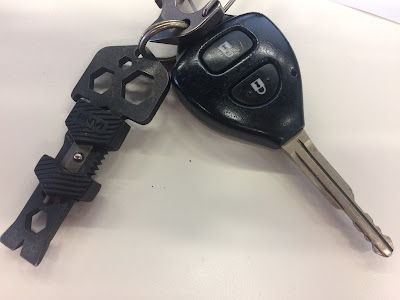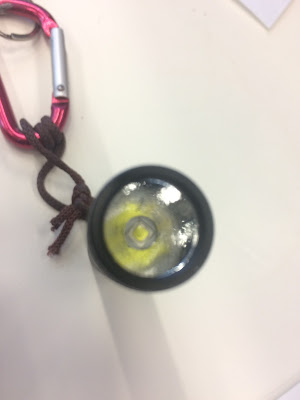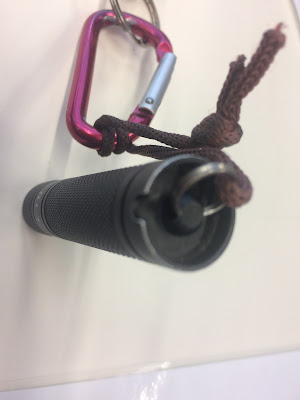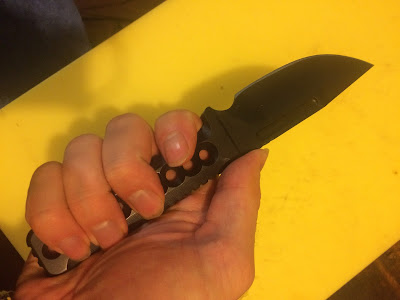 |
| Getting kitted up! |
In the first iteration I played a gung-ho soldier type who met his end being hacked apart by Steel Legion ravagers after a NERF-gun malfunction and failure to adequately transition to CQB weapons. In subsequent games, I signed up with the Junkers; a culty bunch of wasteland scavengers, scrapping by on the edge of the town of Sanctuary. The new persona I developed was the of “Trashman” a somewhat deranged human scarecrow. Central to this character was the philosophy of “you can’t kill what you can’t find” and central to this was my new costume. Regular cammies wouldn't do so I opted for a modified suit of Desert Camo Ghillie.
 | |
| Pushing some food in before heading back into the bushes |
Why is a Ghillie camo suit so much better than just the standard issue AUSCAM uniform for concealment and camouflage?
The uniform that the Australian Military current used is called the DPCU, which stands for Disruptive Pattern Camouflage Uniform. It is a general purpose uniform designed to disrupt the visibility of a soldier from 300 metres and beyond. It is obviously not designed to be the perfect blending colors for all terrain including urban, bush and deserts. The Ghillie (or in Australian military its more commonly known as a Yowie suit although that is changing over time) is designed to go beyond this and actually hide the soldier.
 | |
| Get your cover on, Trashman |
I adorned my suit with “trash” in the form of blue bailing twine from hay-bales and curb-side rubbish bundles, and strips of shredded plastic shopping bags, which I tied to the twine or directly to the burlap strands. I also took to tying on any piece of litter I found dropped in the scout park we based the game in.
I fully acknowledge that doing so took way from the “natural muted colours” the suits provided but it lent to the “human detritus” characterization I was going for and I kept a close eye on the kinds of rubbish you see in abandoned lots, under railway siding bushes and the like, as I was intending to lay in ditches and under bushes a lot. A touch of social engineering was in play here: the litter-blindness people get when having fun. “don’t look at me, I’m work …”
Combat Australia go on to say this of their Ghillie suits: The 5 S's of Cam and Concealment
In military speak the cam and concealment come under the 5 S’s...
· Surroundings:
Have the cam and concealment lesson this consideration comes under the title of surroundings?
I made a habit of moving through the tree lines as often as possible, avoiding open fields and roads. The offered me plenty of duck and cover options and also kept me in the shade out of the hot sun.
· Shape:
Shape refers to the soldier being spotted due to the symmetry of his body eg. straight arms, legs, head and also the symmetry or shape of the troop movement being the soldiers in a group or formation. Ghillie suits work towards disguising this by disrupting the straight lines of a human body and disrupting the pattern of soldiers in formation together so they more closely resemble vegetation.
 | |
| why are all the photos of Bigfoot off center or blurry? |
· Shine:
Another important consideration is Shine, obviously the DPCU has some success in alleviating this concern but the 3 dimensional nature of the suit is far more effective and pretty much eliminates this concern completely. Wearing the Ghillie/Yowie suit answers this concern comprehensively.
I draped the included weapon drape scarf of the suit over and around my NERF launcher, leaving its action free my attached scope accessible. Pulling the mesh down over my face obscured vision a little but greatly masked my shiny skin and glasses
· Shadow:
Shadow is another concern especially when trying to be concealed from air drones. Although the soldier’s body is almost impossible for the drones to spot, the shadow can be very obvious at certain times of the day. The Ghillie/Yowie suit again assists in this regard by breaking up the obvious shadow of a man much like it distorts the shape, making the shadows more closely resemble the natural vegetation.
In the most recent event “ Buyers Regret” we were informed there was a drone in play. I never saw it, but shadows can give you away on the ground too. I was especially careful with this at night as the site had street lamps along its roads which cast long shadows. Any moving shadows were a dead giveaway.
· Silhouette:
These points are also very similar to the issue of silhouette as again it distorts the obvious outline of a soldier silhouetted against the backdrop of distant light sources.
 | |
| Photobombing a mutant Wastelander. never knew |
There
are many advantages to wearing a ghillie camoflauge suit kit over a
conventional flat colored uniform. One of the considerations to be made
when wearing a Ghillie or Yowie suit
are that it is always going to be hotter inside the suit than wearing a
standard camouflage uniform. This is obviously the case as the material
is thicker by its very nature and works somewhat like a fur coat. This
concern is alleviated as much as possible by the design and construction
of the suit.
 |
| Junker with a Trashman shadow |
The inside lining is made of sweat mesh which allows air to flow through as much as possible. The strands and individual meaning they are not “clumps” of cloth than can more effectively retain body heat. These strands are similar to single strands of what we call in Australia “hessian” although other parts of the world including the US and the UK more commonly refer to this material as “burlap”.
Please note that although there are some fire resistant qualities to this material it is still highly flammable and should be kept some distance from open flames. Other considerations are that it is obviously heavier than just wearing a uniform (by about 1.5kg) and gathers weight as vegetation gets stuck to it. Retaining vegetation is an intentional characteristic as its optimal to have natural and realistic local vegetation working in conjunction with the suit but will add to its weight as it retains stick and twigs and leaves.
I found that my ankles, knees and elbows picked up the most detritus and that around the ankle hems the burlap fibbers fluffed up and collected the most vegetation. This had a bonus effect of brushing away some of my tracks as I walked, dragging in the dirt as I stalked.
The third consideration is that fact that the suit will make more noise than a standard uniform as it by its very nature displace more vegetation around the soldier when in the prone position or when in the standing position against vegetation in that mater. The suit is most effective when hiding in one place for longer periods of time rather than running. It is best suited therefore to stalking.
 | |
| Popping up from cover to provide more menacing overwatch, remained unobserved |
In the Australian Army there are quite a few regiments where possessing a Yowie suit is required. To my knowledge this very day there is not an issued Ghillie suit, this is intentional so that the soldier becomes capable of constructing his own which in turn, makes more effective camouflage.
I found that the press-stud jacket closure was probably a touch weak ,but with an over-belt it stayed on even when snagged ,and even over my post-apocalyptic tire armor a button or toggle or two would fix that… Also the drawstring pants was only barely sufficient to keep the pants on and in place, especially when crawling through brush belt loops would assist as would a bracer-system which I could rig, for next time.
 |
| Paint me like one of your French piles of trash, Jack. |
Professionally watermarked photos courtesy of The Professional Hobbyist on Patreon here and on Facebook here.






























